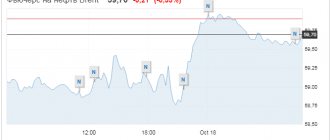02/22/2020 1 312 0 Reading time: 19 min. Rating:
Author
: Konstantin Bely
Today there will be a big financial education on the topic of the stock market, in which we will talk about what types of securities exist. After reading the publication, you will learn what fixed-term and perpetual securities, primary and derivatives are, the concept and essence of all main types of securities. I will make a brief description and provide links to other articles on the site where this or that type is described in more detail, so go ahead for details. So, let's begin.
Types and features of debt securities
To develop, expand and develop new markets, modern enterprises need financial influence. Some organizations apply for a targeted loan to solve their problems. Other large companies raise funds by issuing and placing securities on the stock market. Investors are interested in purchasing high-quality financial instruments , since they are highly likely to receive income. The following types of debt securities are widely used in the domestic market:
- bill of exchange It is a written promissory note that gives the holder the right to require the maker to pay a specified amount stated on it;
- bond. According to it, the company is obliged to pay the investor a nominal amount after a certain period of time;
- treasury bonds. The peculiarity of this debt security is that the issuer is the state;
- savings certificate. This document is prepared by credit institutions.
By issuing securities, commercial and government enterprises raise the necessary amounts of money for a certain period of time. Upon its expiration, debts must be repaid in full.
General concepts about financial instruments
Financial instruments: essence, types Basic financial instruments of the stock market Classification of financial instruments Financial instruments and their role in assessing the investment attractiveness of a company Information support for financial instruments The Ministry of Finance adopted Resolution No. 74 dated December 12, 2018, which approved the National Accounting and Reporting Standard “Financial Instruments” " But not all accountants have a clear understanding of what a financial instrument is. In connection with the adoption of the standard, many questions arose, some of which this article is intended to clarify.
As the capital market developed, new types of financial instruments appeared (forwards, futures and options contracts, swaps, etc.). In modern conditions, the most detailed definition of the concept of “financial instruments” is given in the international accounting standards “Financial Instruments: Disclosure and Presentation of Information”, which came into force on January 1, 1996 (IAS 32). A financial instrument is any contract that simultaneously increases the financial assets of one corporation and the financial liability (equity or debt) of another corporation.
Thus, financial instruments (from the English financial instrument) include:
- cash;
- a contractual right to receive cash or another type of financial asset from another corporation;
- a contractual right to exchange financial instruments with another corporation on potentially favorable terms.
Financial obligations include the following contractual obligations to pay another corporation:
- cash or provide another financial asset;
- exchange a financial instrument with another corporation on potentially unfavorable terms (for example, selling receivables at a discount).
The following type characteristics allow a transaction to be qualified as a financial instrument: the transaction is based on financial assets and liabilities; the operation takes the form of an agreement (contract).
Financial instruments: essence, types
A financial instrument is any contract through which the financial assets of one enterprise and the financial liabilities (debt or equity) of another occur simultaneously.
There are primary financial instruments, represented by cash, types of securities, accounts payable and receivable for current transactions, and secondary, or derivatives. There are 4 types of markets - foreign exchange, futures, money market and stock market. Each of them uses its own financial instruments, i.e. documents that can be sold or transferred to receive money. Securities are traded on the stock market, and they are its main instrument. In essence, these are certain types of obligations with the help of which funds are invested - investing. Stock market instruments can be divided into 2 large subgroups:
- basic instruments (which include bonds and shares, bills, mortgages, bank certificates, in a word, everything that in itself represents the right to a certain price asset). These also include accounts payable and receivable for current operations. For example, a share gives its owner the right to a share in the company, a bill gives the holder the right to receive the amount specified in it, etc.;
- derivative instruments (options, bills, checks, futures, etc.).
Main financial instruments of the stock market
Primary financial instruments include:
- loan agreements;
- loan agreements;
- bank deposit agreements;
- bank account agreements;
- financing agreements for the assignment of monetary claims (factoring);
- financial lease agreements (leasing);
- surety agreements and bank guarantees;
- equity and cash based contracts.
Credits and borrowings are one of the most common financial instruments in the financial market.
When performing transactions, the organization that acts as the lender allocates funds to the borrower. He, in turn, must return them. Bank deposits.
The borrower is the bank, which subsequently, after a certain time, must pay the lender interest for using the amount. A special feature is the fact that a bank deposit agreement must be drawn up in writing.
Leasing operations.
They are very common lately, and this is due to the fact that they are convenient for all parties who take part in the transaction. According to the concluded agreement, the lessor must purchase the equipment or property that the tenant wants to rent. The purchase is made from a third party called the seller. The lessor remains the owner of the property, but despite this, the lessee bears the risk of any losses. As a result of such a transaction, the lessor receives an asset - a long-term investment, and the lease recipient receives an obligation to pay a certain amount for the lease. Leasing operations are regulated by the National Accounting and Reporting Standard “Financial Lease (Leasing)”, approved by Resolution of the Ministry of Finance dated November 30, 2018 No. 73.
The main ones are those securities, the essence of which is property rights to an asset (this can be money, property, goods, resources, etc.). Newcomers to the stock market do not always understand the difference between the main financial instruments of the stock market. These primarily include shares.
Shares are those securities that assign to their owner the fact of participation in the formation of the fund of a joint-stock company, and those that give the owners the right to receive profit from the activities of this company. This instrument is widely represented both in the Belarusian and global markets. Shares are classified as low-liquidity (i.e., difficult to convert into money), but highly profitable instruments. A share is an investment instrument; the invested funds can only be returned if you sell the existing securities.
Shares provide an opportunity to receive income, but the amount of this income is not known in advance and is not even guaranteed. What it will be is determined by the joint stock company that issued the shares; it is based on the income received by the company for the year. Income from shares depends on how exactly the enterprise (joint stock company) operated. If a profit is made at the end of the year, the shareholder will receive income. If there was no profit, then the shareholder will receive nothing. A joint stock company can grow or shrink, investors will invest or bypass the company - the share price will change accordingly. To receive a constant and high income from stocks, you need to constantly monitor changes in the market and news on the stock exchange, sell and buy these securities.
Shares are divided into categories depending on the privileges that their owners receive with their help. Preferred shares make it possible to fix part of the property if for some reason the owner declares himself bankrupt. That is, if the company goes bankrupt, the money invested will be returned. Shares are an equity instrument (in this context, an investment in another company), so treasury shares, as well as interests in a joint venture or subsidiary, are excluded from this definition.
Thus, a financial instrument represents a link between the assets or rights of a company, on the one hand, and the liabilities or equity instruments of another company, on the other.
Another category of securities is bonds. They confirm that their owner gave money to the one who issued the bonds, and the one who issued the bonds is obliged to pay this money within the agreed period, and the owner will receive a pre-agreed income. A bond is an instrument for immediate income; it is valid only for a certain period. The income of the bond owner is known initially; it is calculated based on the par value of the security. This is a fixed value (which is the main difference from a stock). A bond also differs from a bank deposit in that it can be sold; it is a tradable instrument. Bond prices also change, although not as dramatically as stocks.
There are significantly fewer bonds on the Belarusian market than on foreign markets, but in terms of the volume of transactions, it is bonds that occupy a leading position (due to government securities). Bonds have their own classification. They may vary:
- by issuer (the one who issued them) - be state, municipal, corporate;
- by type of income - there are discount (without fixed income), coupon (with fixed income) and with a floating interest rate;
- if possible, exchange - there are convertible and non-convertible.
Another completely separate financial instrument of the stock market is commodity assets, i.e.
real goods (gold, cotton, oil, grain, etc.), but purchase them on the stock exchange as a financial asset. This is due to the fact that the cost of these goods is growing all the time, so such a purchase saves money and protects them from inflation and depreciation. And in order not to store goods at home, stock investors came up with settlement contracts - options and futures, i.e. secondary (or derivative) financial instruments, which will be discussed below. A security is a document drawn up in the prescribed form, indicating the ownership of its owner for a certain amount of money or specific property values. Securities are rights to resources that are separated from their basis and have their own material form (for example, in the form of a paper certificate, account entries). They must meet such fundamental requirements as negotiability; availability; regulation and recognition by the state; liquidity; risk; performance obligations.
If securities have a price asset underlying them, they are called derivatives. Receivable and payable financial debt. It is necessary to distinguish between receivables and payables, for which settlement will be made in cash or securities (financial instrument), and debt, for which settlement will be made in goods (not a financial instrument). A financial instrument also does not include accounts receivable and payable to tax and other authorities.
Secondary financial instruments arose as a result of the transformation of traditional financial relations associated with the acquisition of property rights, as well as partly loan and credit operations.
A derivative financial instrument, derivative (English derivative) is an agreement (contract) under which the parties receive the right or undertake an obligation to perform certain actions in relation to the underlying asset (which can be the primary financial instrument). Usually the opportunity to buy, sell, provide, or receive some goods or securities is provided. Unlike a direct purchase/sale agreement, a derivative financial instrument is formal and standardized, initially providing for the opportunity for at least one of the parties to freely sell this contract, i.e. is one of the securities options. The price of a derivative and its pattern of change are usually closely related to the price of the underlying asset, but are not necessarily the same.
At its core, a derivative financial instrument is an agreement between two parties whereby they undertake an obligation or acquire the right to transfer a specified asset or sum of money on or before a specified date at an agreed upon price. Typically, the purpose of purchasing a derivative is not to physically obtain the underlying asset, but to hedge price or currency risk over time or to obtain speculative profit from changes in the price of the underlying asset. The final financial result for each party to the transaction can be either positive or negative.
Modern instruments appeared because most market participants had a desire for speculative transactions. Speculation is an investment in risky assets that, if possible, will allow for large amounts of profit.
A distinctive feature of derivative financial instruments is that the total number of obligations under them is not related to the total number of the underlying asset traded on the market. Issuers of derivatives are not necessarily the owners of the underlying asset. For example, the total number of CFD contracts (CFD is a contract for difference in prices concluded between a buyer and a seller through a broker) for shares of a certain company can be several times greater than the number of issued shares. Buyers and sellers of CFD contracts are not initially focused on the delivery of real shares; they are only interested in the difference in price that arises for these shares over a period of time specified in the contract or under specified conditions.
A derivative financial instrument has the following characteristics:
- its value changes following changes in the price of the underlying asset (interest rate, price of a commodity or security, exchange rate, index of prices or rates, credit rating or credit index, other variable);
- to acquire it, small initial costs are sufficient compared to other instruments, the prices of which react in a similar way to changes in market conditions;
- settlements on it are carried out in the future.
The following types of derivative financial instruments are known.
Hedging is a way to compensate for possible losses from the occurrence of certain financial risks; insurance of the price of goods against risk. Every scheme that involves financial management allows you to minimize risks, and it has the right to be called hedging. A forward contract, in essence, is an agreement for the purchase and sale of a commodity or financial instrument with an obligation to deliver and settle in the future. The contract has its own standards depending on the quantity and quality of the goods that are the main object of the transaction. That is, according to the concluded agreement, the seller has an obligation to deliver a certain amount of goods within a certain period of time. A futures contract (futures) is a type of securities aimed at profiting from price changes. They represent one of the types of forward, and this type is widespread, especially on financial exchanges, and information about these data is published in the special press. This type of transaction has the main purpose of speculation, and futures are a special contract. Futures have become most popular in trading agricultural products, as well as in trading transactions in metals and other products.
Swap is an agreement between two entities regarding the exchange of obligations or assets in order to improve their structure, reduce risks and costs. That is, the transaction implies payment of a fixed percentage on a certain date. There are several types of swaps, but the most common are currency swaps. In general, lending can be carried out according to a variety of schemes. In such conditions, it is possible to combine the efforts of several service clients. This will reduce the costs of each client and at the same time experience significant savings from various transactions. In order to simplify the calculation and analysis procedure, an operation such as an interest rate swap was invented. Its essence is to transfer the difference in interest rates. This amount is not sent from one hand to another, but is a kind of base for calculating interest. As a rule, interest is calculated once a year or even more often.
An option is one of the types of futures; however, unlike futures and forward contracts, options do not require the sale or purchase of the underlying asset, which, under unfavorable conditions, can lead to direct or indirect losses for one of the parties. Options can be very different - on stocks, on currencies and even on futures. They are developing the idea of futures and due to this they have gained momentum in popularity. With such instruments you can suffer big losses, but also get high profits. An option sometimes gives the right to buy, in which case it is called a call option, and if it gives the right to sell, it is called a put option. There is also the concept of “option price,” which refers to the amount given by the buyer to the seller. There is also such a thing as the “strike price” - the price of the underlying asset at which the owner can sell the asset. It should be noted that the option has a peculiarity: the buyer does not buy assets, but the right to purchase them. Based on their expiration dates, options are divided into:
- European – the contract allows you to buy or sell assets for only one day;
- American – you can have surgery any day.
REPO transactions are an agreement to borrow securities against a certain guarantee of funds or funds against securities (sometimes called a securities repurchase agreement). This is a kind of agreement that securities will be borrowed against a guarantee. A direct repo transaction involves the sale of a package of documents, and an obligation is created on the party that sells to buy these securities back at a certain price. A direct repo operation has as its main goal to attract the necessary amount of finance and placement of those resources that are temporarily free. From an economic point of view, the situation is obvious, because in the process of its completion, one party receives money, and the second, in turn, can make up for the lack of securities.
Classification of financial instruments
Financial instruments by type of asset can be divided into:
- currency;
- interest;
- with a fixed income;
- with floating income;
- price
Foreign exchange financial instruments arise in the process of exchanging one currency for another.
In particular, these include instruments such as currency pairs on Forex, which involve the delivery of one currency for another currency at a certain rate. Interest-bearing financial instruments provide their owner with a certain income at a fixed or floating interest rate. These include, for example, bank deposits and coupon bonds.
Price-based financial instruments provide their owner with income in the form of an increase in their market value. These include stocks, precious metals, etc. Financial instruments by market type are divided into:
- credit financial instruments;
- FOREX market instruments;
- exchange-traded financial instruments;
- insurance market instruments;
- instruments of the precious metals market.
A credit financial instrument involves a contract between two parties, according to which one of the parties receives a loan and assumes obligations to repay it with agreed interest, and the second party (the one who issued the loan) receives the right to the repaid amount and interest.
Credit financial instruments include, for example, bank cards. Instruments of the international foreign exchange market FOREX are contracts concluded for the purpose of exchanging one foreign currency for another. Exchange-traded financial instruments or stock market instruments represent the entire variety of securities traded on the stock exchange. These include stocks, futures, options, depositary receipts, etc.
Instruments of the insurance services market include all contracts concluded between two parties in such a way that one of the parties undertakes to compensate for all losses arising from various types of force majeure, and the other party receives the right to this compensation. An example of an instrument of this kind is a regular insurance policy.
Instruments of the precious metals market are used mainly for the formation of reserves and represent gold, platinum, and silver in their pure form. The peculiarity of this kind of tools is their irrelevance, i.e. one of the parties receives an asset in the form of a precious metal, and the second party does not assume any obligations.
Financial instruments by circulation period are divided into:
- short-term financial instruments;
- long-term financial instruments.
Short-term financial instruments include those whose maturity does not exceed one year.
Long-term instruments are those whose circulation period is one year or more (including perpetual instruments). Financial instruments according to the type of obligations arising are divided into:
- debt;
- equity
Debt financial instruments include those financial instruments that oblige one of the parties to pay the other party a certain amount of money (this obligation may be accompanied by a number of conditions, such as the payment period, interest, etc.).
Equity financial instruments are those that give their owner the right to a certain share in the issuing company (which issued the financial instruments). These include shares, investment certificates, etc.
Financial instruments according to risk level are divided into:
- relatively risk-free;
- low risk;
- with an average level of risk;
- with a high level of risk;
- with an extremely high level of risk.
Short-term government bonds can be called risk-free financial instruments.
These also include hard currency or precious metals for short investment periods. Low-risk financial instruments include deposits in reliable banks that are not subject to the state deposit insurance program, checks and bills issued by large banks. Investments in this kind of financial instruments are classified as conservative. The medium risk group includes, for example, shares. The risk for such financial instruments is within the market average. A high level of risk is typical, for example, for shares of companies belonging to the so-called. second echelon. The risk of such financial instruments exceeds the market average, and investments in them are already classified as aggressive.
Finally, an extremely high level of risk is characteristic, for example, of shares acquired in various types of venture funds. Investors purchasing third-tier shares also take on the same level of risk.
Financial instruments (assets) are one of the new economic concepts that came to Belarus from the West during the formation of the foundations of a market economy. There are different interpretations of the concept of “financial instrument”.
In the most simplified approach, there are 3 types of financial instruments:
- cash in the cash register, on settlement and foreign currency accounts of the organization;
- credit instruments (bonds, loans, deposits);
- methods of participation in the authorized capital of a corporation (shares, shares).
Financial instruments and their role in assessing the investment attractiveness of a company
Any operation with a financial instrument - issue, purchase, sale, exchange - is inevitably associated with a change in the composition and structure of sections of the balance sheets of its participants.
Therefore, the impact of such transactions on the idea of the financial condition of the company is manifested in various aspects. On the one hand, financial assets and instruments are an object of investment and speculation; on the other hand, any financial instrument is an asset that sometimes occupies a very significant place in the company’s balance sheet. In addition, some financial instruments, such as options, carry the potential for large outflows of cash, cash equivalents or other assets, which, under certain market conditions, may materialize and lead to at least losses, sometimes significant ones. Any financial asset on the balance sheet can, on the one hand, mean a source of current (regular) and capitalized income (for example, shares of a third-party issuer owned by the company and shown in the assets of its balance sheet can generate income in the form of dividends, as well as deferred income income from an increase in the exchange rate price), and on the other hand, potentially incur a loss (for example, in the event of a collapse in the price of securities of a third-party issuer, when the current price falls below the cost at which these securities were previously purchased).
As for financial liabilities, for example, attracting large amounts of borrowed capital in the form of a bond issue or a bank loan means increasing the company’s financial risk and, under certain circumstances, can lead to a deterioration in its position in the capital market and complicate relations with counterparties.
Since data on financial assets, liabilities, and instruments are reflected in companies’ balance sheets, it is no coincidence that in recent years the problem of transparency of public reporting and its accessibility to investors, creditors, and counterparties has been actively discussed. Transparency means, firstly, a reliable and fair presentation in the reporting of all assets and liabilities of the company and, secondly, the presence in the reporting of data, including analytical transcripts, notes and explanations, sufficient to form an objective picture of the financial condition of the company. The concept of reliability and integrity, in turn, presupposes a correct assessment of all reporting items. Publicity of reporting means its availability to all interested parties; in addition, national specificity in the interpretation of this concept is also possible.
Information support for financial instruments
Information support for the use of financial instruments in the market is the following types of information:
- regulatory – legislative and regulatory acts governing the issue and circulation of securities;
- accounting - Statement of financial results (profit (loss) per share), Statement of changes in capital (dividends, increase in authorized capital due to additional issue of shares, etc.);
- statistical – the volume of long-term, short-term and other financial investments;
- analytical – analytical reviews and assessments of financial analysts, information officially published by the National Bank and other bodies.
The following indicators are used to evaluate financial instruments:
- dividends;
- volume of transactions on the stock exchange;
- characteristics of transactions;
- urgency;
- securities rates, etc.
Ida Arsentieva , auditor
Bonds
A debt security is a bond issued by large enterprises and governments that confirms that after some time the investor will receive interest and a specific amount of money. Among the features of bonds are:
- release is carried out strictly for a certain period;
- in the event of liquidation of the issuer, the owner of the bond has the right to take part in the division of property;
- guarantee of income on invested capital;
- minimal risks for investors.
Such debt securities are among the most reliable. Bonds are either interest-bearing or non-interest-bearing; with a limited circulation period and free circulation; bearer and registered.
Debentures
To define what debt securities are, it should be understood that they primarily represent the debt obligations of the issuing company towards the holder.
It is essentially a loan in which principal and interest are paid. Debt securities can be issued by the state, international organizations, local governments, commercial companies, and credit institutions. The securities may or may not be secured by collateral. The loan agreement may contain various conditions.
Features of debt securities:
- The face value is the basis for calculating interest and is paid on the maturity date.
- The maturity date is the date on which the issuer is obligated to pay the holder the principal amount and close the obligation. Securities can be short-term (up to a year), medium-term (1-10 years), long-term (from 10 years).
- Coupon rate - this is the name of the interest rate that the issuer pays to the owner of the securities; it can be floating or fixed. Floating depends on short-term interest rates and is fixed for a specific period. Short-term securities do not require a coupon, because they are issued at a discount (the difference between the nominal price and the cost of the security).
- The coupon payment date is the period during which the interest payment is made.
- Derivative debt securities are a loan that involves some special conditions (example: convertible bonds that can be exchanged for shares on a specified date).
When purchasing a security, the client fixes the rate of return at the time of the transaction. It depends on the purchase price, coupon rate, accumulated coupon profit, which is paid to the previous owner of the paper. The liquidity of securities depends on a lot of factors (market segment, issue volume, market situation, level of supply/demand, etc.).
The main advantages of debt securities:
- A good alternative to bank deposits - higher income.
- Opportunity to sell securities before maturity.
- Preservation of accumulated interest upon sale, no penalties.
- A large selection of combinations of conditions - currency, profitability, investment period, risks.
- The opportunity to form a good portfolio is to buy securities of enterprises from different countries and economic sectors, diversifying investments.
Advantages of debt securities for each party
The turnover of debt securities occurs on the over-the-counter market. A significant part of them passes through electronic trading platforms . The advantage of investing money for investors is that the profitability is known in advance, there is no need to track the dynamics of the value of the securities. For companies, a positive quality is that debt securities allow them to attract the necessary amount of funds to solve business problems. In Russia, promissory notes and bonds are widely used.
Advantages and disadvantages
Advantages of debt securities for investors:
- An alternative to bank deposits;
- You can sell on any working day on the stock exchange (if we are talking about bonds);
- Saving interest on sale;
- Large selection of debt securities with different yields and maturities;
Advantages of debt securities for enterprises:
- Possibility to borrow for a long time;
- Large sums of money are available for borrowing;
- Improving credit rating and trust;
- A fair assessment of issuing a loan at interest in accordance with the profitability and risk of the issuer;
Money
Real money, cash, is a payment instrument in the global economy, operating at all its levels, from international trade relations to banal payment for goods in a supermarket.
Cash components include immediate cash and variations in its transfer and settlement. Cash, cash, is the same money that we use in everyday life. These are national currencies expressed in the form of banknotes and coins. Their quotes are regulated by the national bank, based on the economic situation.
Today, to transfer money we use not only wallets and banknotes, but also other methods: plastic cards, checks, online payment systems. Cryptocurrencies have appeared relatively recently. They are not yet regulated by law and are not considered full-fledged money, but it is quite possible that in the future they will also take a place on this list.
Tools for raising funds
Many entrepreneurs perceive debt securities as a tool for obtaining additional funds at their disposal without the need to give someone a part of the company or the right to make decisions regarding its work. Compared to a regular bank loan, this option offers a lot of advantages: lower interest payments, reliability, no collateral, etc.
Bank certificate
Only banks that meet the established requirements have the right to issue such certificates. A bank certificate is a debt security that can be compared in principle to a bank deposit.
The certificate form assumes the presence of all degrees of protection and is produced only in specialized printing houses with licenses. If any of the details on the form are missing, it immediately loses its status as a security. Registration journals, folders with certificate stubs are stored in fireproof cabinets and cash vaults.
Unlike a check or bill of exchange, a bank certificate is not used as a means of payment/settlement. When the deadline for circulation of the paper arrives, the holder receives the deposit amount and interest.
In the process of issuing securities by a bank, the funds received are included in its borrowed capital and must be included in the capital, which is the basis for determining the calculations of all important financial standards of the bank. These are borrowed funds from the bank. To issue the paper, you just need to have your passport with you; you can pay in cash or with funds from a deposit already made in the bank.
The main disadvantage of a bank certificate is the impossibility of its participation in the insurance system for all deposits of individuals. Interest is paid when the certificate is redeemed upon presentation of the paper. The main purpose of the paper is to borrow money from the bank for the implementation of a specific project or activity.
Monetary relationship between issuer and borrower
Debt securities are a type of loan agreement. All types of securities are examples of capital investments for the purpose of investment, on the one hand, a legal means of financing investments. Organizations are able to raise additional funds without having to sell assets or shares in the company.
But for the buyer, debt securities are a means of earning money only, since they do not give the right to a part of the issuing company, its property or assets. The only purpose of purchasing securities is to receive profit in the form of interest without any personal contribution to the development of the issuer (except money), which can be considered passive income.
At the time of purchase of securities, the investor and the issuer enter into financial, economic, civil legal relations that fall under the regulations of the conditions of issue of the Central Bank.
The main value of the Central Bank is providing investors with the opportunity to participate in a variety of relationships/operations based on the conditions and content of the Central Bank.
While in the case of bank lending the subject of the relationship between the borrower and the lender is the amount of funds, the investor and the issuer work with securities backed by capital (money invested for certain purposes, participating in socially useful or entrepreneurial activities ).
At the time of sale of a security, the previous owner gives the new owner his place as an investor and the right to participate in transactions with securities. But all guarantees are already provided by the issuer - in terms of compliance with conditions, payments, treatment, etc.
Derivatives of matter
Derivatives are the already mentioned derivatives. These are forward contracts that are concluded not for a specific asset, but on the terms of its purchase or delivery. The most common derivative derivative is futures.
By purchasing a futures, you become the owner of the right to receive delivery of a commodity or other asset within its framework. According to statistics, only 2-3 percent of all such contracts reach delivery, while the remaining futures are resold for speculative purposes. This is a very volatile mechanism, that is, capable of changing value in a short time. That's why it's risky.
Another representative of this group is the option. This is the right to purchase a product at a predetermined price. You can make money on it if you fix one price, pay the option amount, and buy the product when it rises in price. Afterwards, sell for a profit. An option is a rational method of gambling, since possible losses are known in advance - they only amount to the cost of repurchasing the option right.
Savings and certificates of deposit
Savings certificates are debt securities that are an obligation of credit institutions to the depositor.
They resemble deposits, but most often they are not registered. This means that you can transfer the certificate to a third party and he will receive money and interest on it.
Savings certificates can be valid or unlimited. In our country, this is an already obsolete class of debt securities. Bank branches no longer issue such certificates.
The certificate of deposit is issued only for legal entities. It can be resold.
State control
It would be quite fair to say that working, active stock trading of a country is the basis of its economy. This is a method of increasing capital that works positively for both investors and the country’s budget. Investors receive income, and the state receives taxes from it. Also, a healthy trade position attracts foreign capital, which has an even better impact on the country's growth as an economic player.
Accordingly, in such a situation, control by the authorities becomes very important. First of all, clear, clear, white legislation. Secondly, encouraging citizens to make deposits and trying to popularize investing. Thirdly, personal presence.
This refers not only to audits and tax audits, but also to the presence of state-owned companies at auctions. In Russia, the banking sector rests on the shoulders of the Bank of Russia, which is also a participant in the trading session. It buys debt, sells it, adjusts interest rates, lends to reliable debtors, and carries out other dynamic activities.
Another factor is the protection of the exchange from insolvent investors. Therefore, state laws prohibit private individuals from conducting independent transactions with the Central Bank. In return, they get access to proven and licensed brokerage companies, which undertake to represent the interests of their client on the stock exchange.
What is more profitable for an investor?
Bills serve to raise capital one-time and allow you to regulate private issues with investors. But the debt remains tied to paper form. Therefore, the physical loss of a security is comparable to the loss of capital.
Treasury certificates provide a 100% guarantee of return of the deposit. But in practice they are used to offset debts between the state and the enterprise.
Savings certificates are similar to bank deposits. They are not subject to insurance, and in the event of bankruptcy of the financial institution that issued them, you can lose the invested funds.
The benefits of debt securities for the participants in the transaction are difficult to underestimate. The investor receives income for the use of his funds. Issuer - financing. Intermediary organization – percentage of the transaction. State – benefits for economic development.
Other markets
We talked above about the securities market. But there are other areas available to the trader to try to make money. Moreover, not only individuals, but also companies and even states are involved here.
The credit market is the totality of all debt obligations of the economy of a certain sector. Papers for accounts payable and receivable are sold. For example, here banks can buy debts from each other. In part, this is how consumer loans are refinanced.
The insurance market trades its obligations. Both insurance companies and financial industry participants are involved here. These spheres are mutually intertwined with each other, which is why such a market is formed. Remember that there is an insurance clause in loan documents?
Precious metals and raw materials. The futures contracts already described above work. Oil, gas, gold, sugar, wheat and much more are supplied. The main market for global industry, since the final retail price depends on the prices of local goods.
Is it profitable for an issuer to take loans using securities securities?
Borrowing using debt securities is clearly beneficial to the issuer. This is a good tool for raising capital. And this method is definitely better than a bank loan or mortgage.
What attracts DSBs:
- cheaper than a bank loan
- longer borrowing period possible
- opportunity to attract more funds
- no collateral required
- financing flexibility
- increasing the financial rating of the enterprise on the market
Despite some difficulties in issuing debt securities, they are more profitable for the issuer than a bank loan. However, their implementation will require a positive company rating on the financial market.











